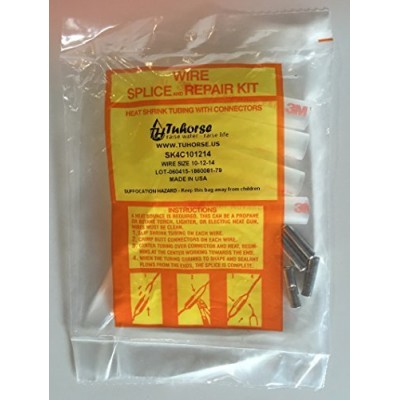Pond Pumps Canada is part of the Amazon Affiliate Network. We may receive payment for items purchased through the Amazon website.
This wire splice kit comes with 4 x butt connectors and 4 x 3M clear dual wall heat shrink tubings that are suitable for connecting #10 #12 or #14 pump wires. The tubing used in these kits was developed especially for groundwater applications. The inner wall of a special thermoplastic adhesive melts and flows when heat is applied. The tubing rapidly shrinks to a skin-tight fit, forcing the melted adhesive to flow and cover the substrate. Upon cooling the adhesive solidifies, forming a permanent flexible, waterproof barrier. The clear tubing allows the additional advantage of seeing inside the splice. Ideally using for splicing a submersible deep well water pump and other waterproof applications. Instructions come with the kit. Made in the USA
- 4 x 3M Tubings and 4 x butt connectors
- Dual Wall Heat Shrink Tubing and Pure Electrolytic Copper Connector
- Clear tubings allow you to see through inside the splice
- Ideally for submersible deep well pump application
- Quality 3M tubings for groundwater and other water tight applications
Well Pump Wire Splice Kit, Submersible 3M Dual Wall Heat Shrink Tubing and Copper Connector for 4 Wires, 10#12#14 AWG.
- Brand: USA Made
- Product Code: SK4C101214
- Availability: In Stock
Related Products
Red Lion RL12G05-2W1V 1/2-HP 12-GPM 2-Wire 115-Volt Submersible Deep Well Pump
Easily pump water from your well to your water tank with the..
Hallmark Industries MA0419X-12A Deep Well Submersible Pump, 2 hp, 230V, 60 Hz, 35 GPM, 400' Head, Stainless Steel, 4"
Pump, Deep Well Submersible Pump, 2HP, 230V 60HZ, 35 Gpm, St..
Red Lion RL12G05-3W2V 1/2-HP 12-GPM 3-Wire 230-Volt Submersible Deep Well Pump with Control Box
Easily pump water from your well to your storage tank using ..
Red Lion RL12G05-2W2V 1/2-HP 12-GPM 2-Wire 230-Volt Submersible Deep Well Pump
This submersible deep well pump is ideal for 4-Inch I.D. or ..
Hallmark Industries MA0414X-7A Deep Well Submersible Pump, 1 hp, 230V, 60 Hz, 33 GPM, 207' Head, Stainless Steel, 4"
Hallmark Industries MA0414X-7A Deep Well Submersible Pump, 1..
Red Lion RL22G10-3W2V 1-HP 22-GPM 3-Wire 230-Volt Submersible Deep Well Pump with Control Box
Move water from your well to your storage tank easily using ..
Dynamic Head
The effect of the Earths gravity on the "lift" or head pressure is fairly simple; for every vertical foot of distance the pump moves the water you are adding one foot of head pressure so the ratio is a 1:1 ratio. The effects of the friction, caused by water as it travels through your hose or pipes, on the total head pressure is a little more difficult to calculate especially as there are slight variations in pipe friction in different hose materials and the smoothness of the inner bore. Basically. for every ten feet of pipe through which the water has to travel travel horizontally will contribute 1 foot of head height; the ratio of the pipe friction loss is a 10:1 ratio.Plumbing fixtures and bends and corners in your hose also increase the total head you must calculate to ensure the proper final volume from your pump. Every corner with a 90 degree elbow in your plumbing will add 1 foot of head pressure with a 1:1 ratio. 45 degree elbows, tees and even insert couplers can all have an impact on the final flow.
If you install a pump 40 feet away from the top of your waterfall which is 6 feet above the pump and the tubing is a single run of 40 feet horizontally then you add 4 feet of head for the tubing length (the 10:1 ratio) to the 6 foot differnetial between the pump location and the final height of the waterfall so your final total dynamic head calculation would be 10 feet. This means your final volume of water flow in this water feature or application would be the volume of flow on the performance curve that equaled the gallons per hour at 16 feet. This volume will certainly be much less than the initial volume the pump can move at an open flow or a zero head.
If in the above example your 40 feet of horizontal tubing run also required 3 elbows of 90 degrees then an additional 3 feet of theoretical head would be added and your final flow result would be at 19 feet on the performance curve of the pump. In this example you would want to choose a pump that has the desired GPH rating at 9 feet of head pressure. Tubing size is also an important factor in accounting for head pressure loss, in general you should never reduce the diameter of the tubing below what the output size of the pump is, this will drastically increase head pressure, and reduce pump performance. For maximum pump performance, using the largest tubing that is practical is the best choice. A best practice is to use a hose with an inner diameter that is the same as your pumps outlet fitting.

